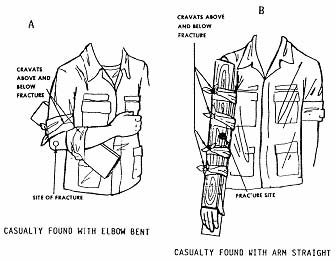Treating Fractures in the Field
Lesson 5: Fractures of the Upper Extremities
5-5
5-5. IMMOBILIZE A FRACTURED ELBOW WITH AN IMPROVISED SPLINT
Immobilize the upper arm and forearm in the position you find them. If the elbow is bent, leave it bent. If the elbow is not bent (arm straight), do not try to bend it in order to apply a sling to the arm.
a. Elbow in Bent Position.
(1) Check the casualty's pulse below the fracture site. If no pulse is found, evacuate the casualty as soon as possible after the splint is applied.
(2) Apply a rigid object (padded, if possible) to the inside of the casualty's limb so it can immobilize the elbow.
(3) Secure the rigid object with at least two cravats (see figure 5-6 A).
(a) Apply at least one cravat above the fracture site (secure the upper arm to the rigid object) and at least one cravat below the fracture site (secure the forearm to the rigid object). Do not apply a cravat over the elbow.
(b) Tie the tails of the cravats in a non-slip knot on the rigid object and tuck in the tails.
Figure 5-6. Improvised splints applied to fractured elbows.
(c) Check the casualty's pulse after each cravat is applied. If the pulse can no longer be detected, loosen the cravat and apply it again. If this does not restore circulation, evacuate the casualty as soon as possible.
(4) Apply a sling and swathe to help support the arm, but do not place the elbow and rigid object inside the sling.
b. Elbow Not Bent.
(1) Check the casualty's pulse below the fracture site. If no pulse is found, evacuate the casualty as soon as possible after the splint is applied.
(2) Apply two rigid objects (padded, if possible) to the casualty's limb. The rigid objects should be long enough to immobilize the elbow and the wrist. The bottom rigid object should extend beyond the fingers of the injured hand. Make sure the inner splint does not press on the axilla.
(3) Place a rolled cravat or similar material in the palm of the casualty's injured hand.
(4) Secure the rigid object with at least four cravats (see figure 5-6 B).
(a) Apply at least two cravats above the fracture site and two cravats below
the fracture site. Do not apply a cravat over the elbow.
(b) Tie the tails of the cravats in a non-slip knot on the outer rigid object and tuck in the tails.
(c) Check the casualty's pulse after each cravat is applied. If the pulse can no longer be detected, loosen the cravat and apply it again. If this does not restore circulation, evacuate the casualty as soon as possible.
(5) Apply two swathes, one above the elbow and one below the elbow.


